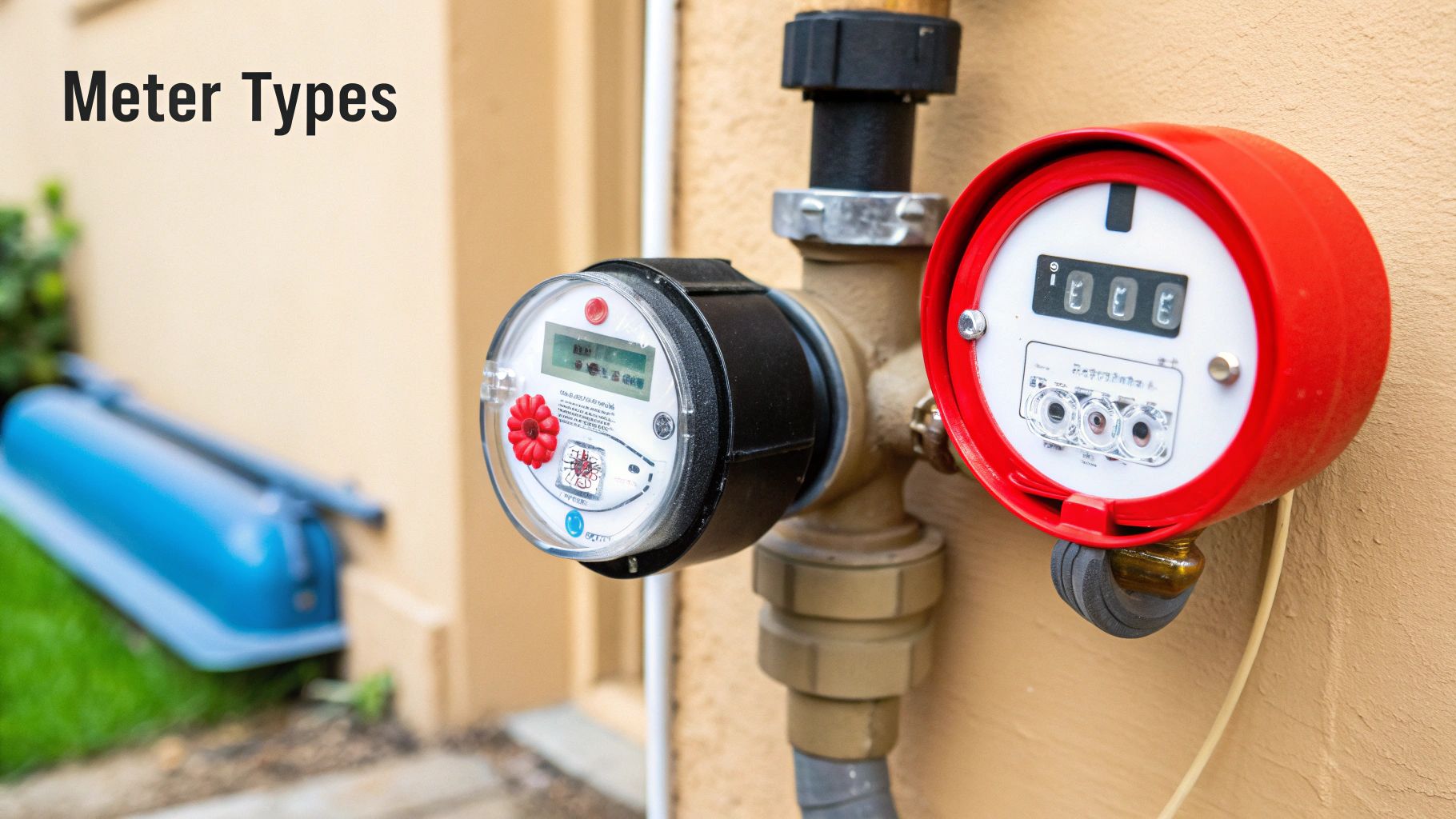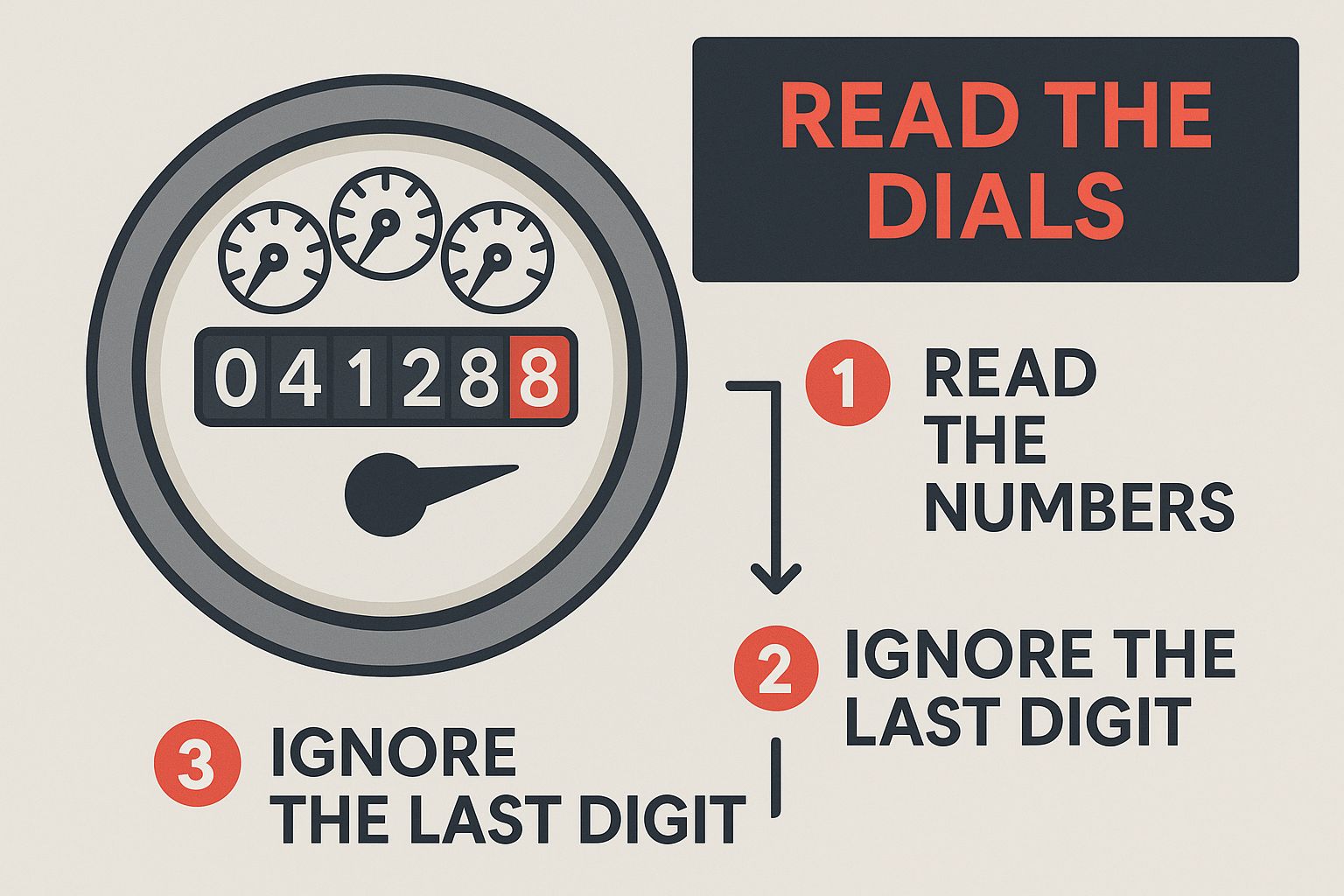Do you ever feel like your water bill is a complete mystery? The key to understanding it, and potentially lowering it, is sitting right at the edge of your property. That little water meter is your best tool for tracking exactly where your money is going and catching plumbing problems before they turn into major headaches.
Learning how to read your water meter is a simple skill that empowers you to manage your home's water consumption. It's the most effective way to spot hidden leaks that can silently drain your bank account. For homeowners and businesses in Oxnard, this knowledge is the first step toward smart water management.
Your Guide to Understanding Your Water Meter in Oxnard
That unassuming box near the street holds the key to your home's water usage. This meter meticulously tracks every gallon your household uses, and knowing how to read it is a valuable skill for any property owner in Ventura County.
Why is this so important? Because it puts you in control. You can verify your utility bills for accuracy and, more importantly, be the first to know if there's a sudden spike in usage—a classic sign of a hidden leak. Catching it early can be the difference between a simple fix and a complex pipe repair. This isn't a secret plumber's trick; it's smart homeownership that protects your property.
Why Your Water Meter Matters
Think of your water meter as a speedometer for your home's water flow. It gives you a running tally of your consumption, which is invaluable for budgeting and conservation. In our area, you’ll typically find one of two kinds: the classic analog style with spinning dials or the more modern digital displays.
Understanding your meter is about being proactive. Don't wait for a shockingly high bill to arrive. By checking the meter yourself, you can spot issues like a constantly running toilet or a slow underground leak long before they become serious. This is especially critical for preventing water waste and damage.
These devices are becoming more important than ever. The global water meter market is already valued at around USD 21.95 billion and is expected to keep growing as we all get smarter about water conservation. This trend highlights how crucial it is to monitor what we're using right at home. You can explore more data on the global water meter market to see how this is playing out worldwide.
Once you know how to read your meter, you gain a new level of confidence. Whether you’re trying to cut back on water use, hunt down a leak, or just make sense of your monthly bill, it all starts with this simple check.
Finding and Accessing Your Water Meter

Before you can read your water meter, you need to find it. For most of us here in Ventura County, it’s usually straightforward. Your first stop should be the curb or sidewalk at the front of your property.
Look for a concrete or plastic box set flush with the ground. That’s the meter box, and its job is to keep your meter safe from weather and daily wear.
Getting inside doesn't require special tools. Most of the time, a large screwdriver or a similar flat tool is all you need to gently pry the lid open. Just lift it carefully and place it next to the box so it isn't a tripping hazard.
Getting a Clear View for an Accurate Read
Once the lid is off, don't be surprised if you find a bit of nature inside. It's completely normal for the box to collect dirt, leaves, and maybe even a few spider webs.
Before you reach in, always take a quick peek for any unexpected critters. After a quick safety check, you can use your hands or a small brush to clear away any debris covering the meter face. It's also a good idea to bring a cloth to wipe off any condensation that might be obscuring the glass.
Your goal is simple: get a crystal-clear look at the dial or digital display. Taking just a minute to clean it off is the key to getting an accurate reading, which is the whole point of checking your meter.
If something seems off with the meter itself or you spot signs of a leak around the pipes, it’s not the time for guesswork. A professional can identify problems you might miss. For local homeowners, getting a comprehensive plumbing inspection in Oxnard is a great way to confirm everything is working as it should and gain peace of mind.
Decoding Your Analog or Digital Water Meter
Now that you can see the face of your meter, you’ll be looking at one of two types: a classic analog display with spinning dials or a modern digital screen. Both are common throughout Ventura County, and both are simple to read once you know what to look for.
The first step is figuring out which one you have. Let's walk through each type so you can feel confident no matter what's in that box.
Reading an Analog Meter
If your meter looks like a combination of an old car odometer and a clock, you've got an analog model. These have been the standard for decades and have a couple of key features to watch.
You'll probably notice a large sweep hand that spins as water flows through the meter. Think of it as a real-time usage indicator. A single full rotation usually means one cubic foot of water (or sometimes 10 gallons) has been used.
The most important part for billing purposes is the series of numbered dials that look like an odometer. You read these numbers from left to right to find your home’s total water consumption. Pay close attention: sometimes the last digit or two will be a different color or stationary. These smaller numbers typically represent tenths or hundredths of a unit, and your water company often ignores them for billing.
For example, if the main, rolling dials show 001234, your home has used 1,234 cubic feet of water since the meter was installed. It's that straightforward.
This image shows a close-up of a common analog meter, highlighting exactly which numbers matter.

This is a great visual guide. The numbers you see here are exactly what your Oxnard utility company uses to calculate your bill each month.
To make things even clearer, here’s a quick reference table for interpreting those numbers.
Understanding Your Meter's Numbers
This table breaks down how to read both meter types at a glance.
| Meter Type | What to Read | How to Interpret It | Example |
|---|---|---|---|
| Analog | The row of rolling numbers, like an odometer. | Read the numbers from left to right. Ignore any final digits that are a different color or stationary. | If you see 001234, your usage is 1,234 cubic feet. |
| Digital | The large number displayed on the LCD screen. | Read the full number from left to right. It’s a direct reading of your total consumption. | A display of 1234.56 means 1,234.56 cubic feet used. |
Keep this in mind, and you'll never be confused by your meter again.
Reading a Digital Meter
Digital meters are the newer models, and they make reading your usage incredibly easy. Instead of dials, you get a straightforward LCD screen that displays the numbers clearly.
Don't be surprised if the screen is blank when you first open the lid. Most of them enter a sleep mode to conserve battery power. Waking it up is usually as simple as shining a bright flashlight onto the small solar panel on the meter's face or just flipping the lid open.
Once it's awake, the display will often cycle through a couple of different pieces of information.
One screen will show your total water consumption, which you read from left to right just like the analog version. A great feature on many digital meters is a screen that shows the current flow rate. This is a fantastic tool for spotting leaks. If every faucet and water-using appliance in your house is turned off, that number should be 0.0.
If you see that flow rate number ticking up when it shouldn't be, or if you're unsure what you're seeing, that’s a good sign it’s time to get a professional opinion. Our teams at Armor Hydro Jetting have seen it all, from issues requiring simple drain cleaning to complex pipe repairs, and we can get to the bottom of any hidden water issues quickly.
Using Your Meter to Find Hidden Water Leaks
One of the most powerful things you can do as a homeowner is use your water meter as a personal leak detective. It's your best first line of defense against hidden plumbing problems that can lead to shocking water bills and expensive damage.
Knowing how to run this simple test can save you a world of headache and money down the road.
First things first, you need to create a controlled environment. Go through your house and make absolutely sure every single thing that uses water is turned off. This includes dishwashers, washing machines, faucets, and showers. Tell your family no flushing for a little while!
Checking for Slow and Steady Drips
Once you're sure no water is supposed to be running, head out to your meter.
You're looking for a small, often overlooked detail on the dial: a tiny triangle, star, or gear-shaped wheel. This little indicator is your leak indicator, and its only job is to spin when even the smallest amount of water is flowing through the meter.
If that indicator is twitching, fluttering, or slowly turning, you have a constant leak somewhere. It’s definitive proof. Water is moving through your pipes when it shouldn't be.
A constantly moving leak indicator is proof of a problem. It could be a silent toilet leak—which are incredibly common—a forgotten drip in a guest bathroom, or something more serious hidden in your walls or under your foundation.
The One-Hour Water Meter Test
What if your meter doesn't have an obvious leak indicator, or you just want to be extra sure? There's another simple, reliable method you can use.
Grab your phone or a notepad and write down the exact reading from your meter. Make sure you get every single digit, including the ones on the far right.
Now, head back inside and enforce a strict no-water-use policy for at least an hour. This part is critical for an accurate test.
After the hour has passed, go check the meter again. If the numbers have moved even a tiny bit, you have a leak.
Finding the leak is the first and most important step. For residents in Ventura County, our expert teams at Armor Hydro Jetting can pinpoint the source with advanced leak detection services in Oxnard, finding the problem quickly to protect your home and your wallet.
When to Call a Professional Plumber
Being able to read your water meter is a fantastic skill for any homeowner. It puts you in control. However, some jobs are not meant for a DIY approach. Knowing when to call in a professional is just as crucial as spotting the problem in the first place.
Think of it this way: you've done your homework. You ran the leak test, and that little indicator is spinning, telling you water is flowing somewhere. You’ve checked every faucet, toilet, and spigot, but you’ve come up empty-handed. This is the moment to call a professional.
Another clear sign? The meter itself looks damaged. If the glass is cracked, foggy with condensation on the inside, or the housing is broken, do not try to fix it yourself. That’s a job for the water utility or a licensed plumber.
Don't Let a Small Problem Become a Disaster
Here’s a scenario we've seen countless times in our work serving Ventura County: a homeowner notices their water pressure has suddenly dropped. At the same time, their meter's leak indicator is going wild. This is a massive red flag.
It often points to a serious break in the main water line between the meter and your house, a leak you will never see. Ignoring it can lead to water silently undermining your home's foundation. The cost of a professional plumber is a tiny fraction of what foundation repair costs. From water heater repair to complex repiping, timely intervention is key.
The best defense is a good offense. A small, hidden leak you ignore today can easily become a burst pipe that floods your home tomorrow. Getting an expert in early saves you stress, money, and potential property damage.
This is a bigger issue than you might think. The water meter market in North America is expected to hit USD 3.67 billion by 2032. A huge chunk of that growth is driven by the need to replace aging, leak-prone infrastructure. You can read the full research about these market trends to see the scale of the problem.
When you have a stubborn leak you can't trace, it’s time to find an expert with the right tools. For locals, knowing how to find a licensed plumber in Oxnard is the next logical step to protecting your investment.
For any plumbing concerns in Oxnard or the greater Ventura County area, Armor Hydro Jetting is your trusted partner. Our experienced team provides reliable emergency plumbing, expert pipe repair, and advanced hydro jetting solutions to protect your home and give you peace of mind. We are the reliable solution for everything from drain cleaning to major plumbing repairs. Visit us at https://armorhydroplumbing.com/ to schedule your service today.
